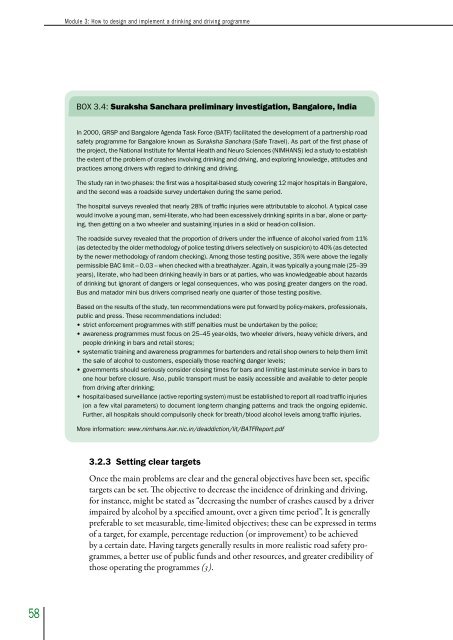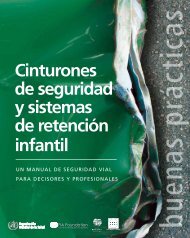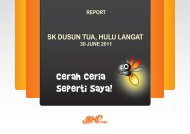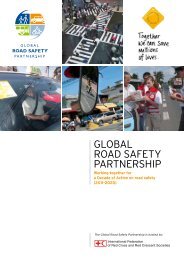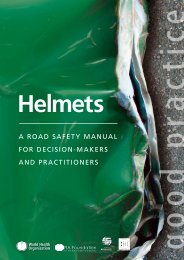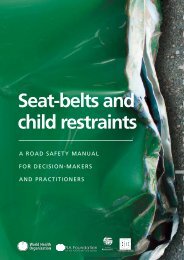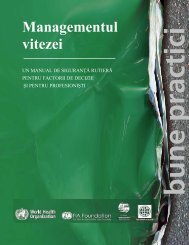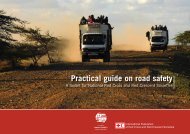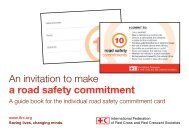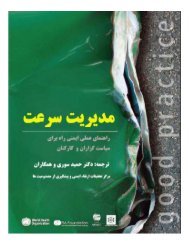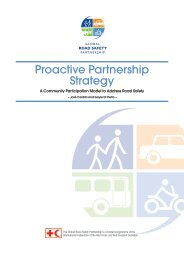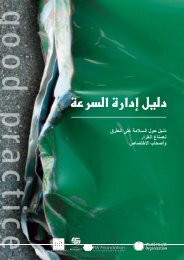How to design and implement a drinking and driving programme pdf ...
How to design and implement a drinking and driving programme pdf ...
How to design and implement a drinking and driving programme pdf ...
You also want an ePaper? Increase the reach of your titles
YUMPU automatically turns print PDFs into web optimized ePapers that Google loves.
Module 3: <strong>How</strong> <strong>to</strong> <strong>design</strong> <strong>and</strong> <strong>implement</strong> a <strong>drinking</strong> <strong>and</strong> <strong>driving</strong> <strong>programme</strong><br />
BOX 3.4: Suraksha Sanchara preliminary investigation, Bangalore, India<br />
In 2000, GRSP <strong>and</strong> Bangalore Agenda Task Force (BATF) facilitated the development of a partnership road<br />
safety <strong>programme</strong> for Bangalore known as Suraksha Sanchara (Safe Travel). As part of the first phase of<br />
the project, the National Institute for Mental Health <strong>and</strong> Neuro Sciences (NIMHANS) led a study <strong>to</strong> establish<br />
the extent of the problem of crashes involving <strong>drinking</strong> <strong>and</strong> <strong>driving</strong>, <strong>and</strong> exploring knowledge, attitudes <strong>and</strong><br />
practices among drivers with regard <strong>to</strong> <strong>drinking</strong> <strong>and</strong> <strong>driving</strong>.<br />
The study ran in two phases: the first was a hospital-based study covering 12 major hospitals in Bangalore,<br />
<strong>and</strong> the second was a roadside survey undertaken during the same period.<br />
The hospital surveys revealed that nearly 28% of traffic injuries were attributable <strong>to</strong> alcohol. A typical case<br />
would involve a young man, semi-literate, who had been excessively <strong>drinking</strong> spirits in a bar, alone or partying,<br />
then getting on a two wheeler <strong>and</strong> sustaining injuries in a skid or head-on collision.<br />
The roadside survey revealed that the proportion of drivers under the influence of alcohol varied from 11%<br />
(as detected by the older methodology of police testing drivers selectively on suspicion) <strong>to</strong> 40% (as detected<br />
by the newer methodology of r<strong>and</strong>om checking). Among those testing positive, 35% were above the legally<br />
permissible BAC limit – 0.03 – when checked with a breathalyzer. Again, it was typically a young male (25–39<br />
years), literate, who had been <strong>drinking</strong> heavily in bars or at parties, who was knowledgeable about hazards<br />
of <strong>drinking</strong> but ignorant of dangers or legal consequences, who was posing greater dangers on the road.<br />
Bus <strong>and</strong> matador mini bus drivers comprised nearly one quarter of those testing positive.<br />
Based on the results of the study, ten recommendations were put forward by policy-makers, professionals,<br />
public <strong>and</strong> press. These recommendations included:<br />
• strict enforcement <strong>programme</strong>s with stiff penalties must be undertaken by the police;<br />
• awareness <strong>programme</strong>s must focus on 25–45 year-olds, two wheeler drivers, heavy vehicle drivers, <strong>and</strong><br />
people <strong>drinking</strong> in bars <strong>and</strong> retail s<strong>to</strong>res;<br />
• systematic training <strong>and</strong> awareness <strong>programme</strong>s for bartenders <strong>and</strong> retail shop owners <strong>to</strong> help them limit<br />
the sale of alcohol <strong>to</strong> cus<strong>to</strong>mers, especially those reaching danger levels;<br />
• governments should seriously consider closing times for bars <strong>and</strong> limiting last-minute service in bars <strong>to</strong><br />
one hour before closure. Also, public transport must be easily accessible <strong>and</strong> available <strong>to</strong> deter people<br />
from <strong>driving</strong> after <strong>drinking</strong>;<br />
• hospital-based surveillance (active reporting system) must be established <strong>to</strong> report all road traffic injuries<br />
(on a few vital parameters) <strong>to</strong> document long-term changing patterns <strong>and</strong> track the ongoing epidemic.<br />
Further, all hospitals should compulsorily check for breath/blood alcohol levels among traffic injuries.<br />
More information: www.nimhans.kar.nic.in/deaddiction/lit/BATFReport.<strong>pdf</strong><br />
3.2.3 Setting clear targets<br />
Once the main problems are clear <strong>and</strong> the general objectives have been set, specific<br />
targets can be set. The objective <strong>to</strong> decrease the incidence of <strong>drinking</strong> <strong>and</strong> <strong>driving</strong>,<br />
for instance, might be stated as “decreasing the number of crashes caused by a driver<br />
impaired by alcohol by a specified amount, over a given time period”. It is generally<br />
preferable <strong>to</strong> set measurable, time-limited objectives; these can be expressed in terms<br />
of a target, for example, percentage reduction (or improvement) <strong>to</strong> be achieved<br />
by a certain date. Having targets generally results in more realistic road safety <strong>programme</strong>s,<br />
a better use of public funds <strong>and</strong> other resources, <strong>and</strong> greater credibility of<br />
those operating the <strong>programme</strong>s (3).<br />
58


